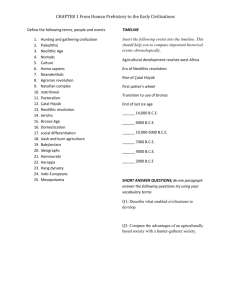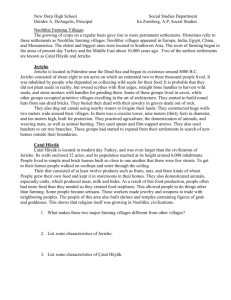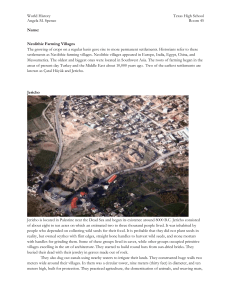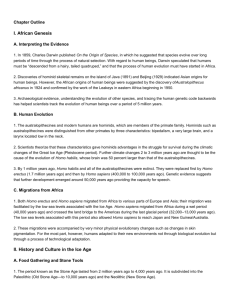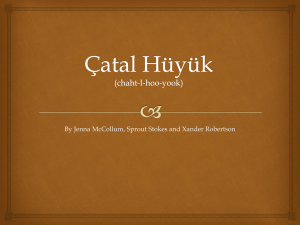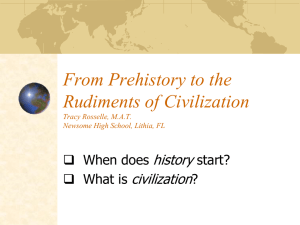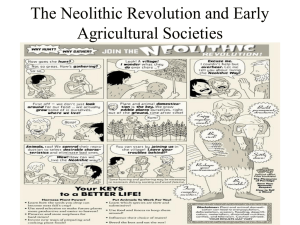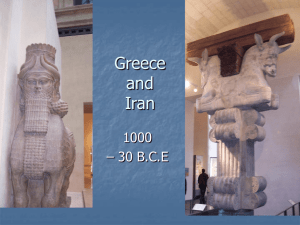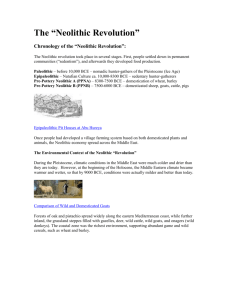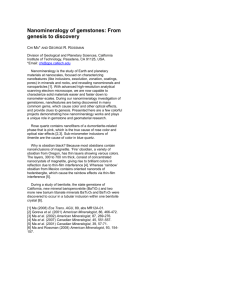userfiles/202/my files/grade 6 ch 5 notes?id=469928
advertisement
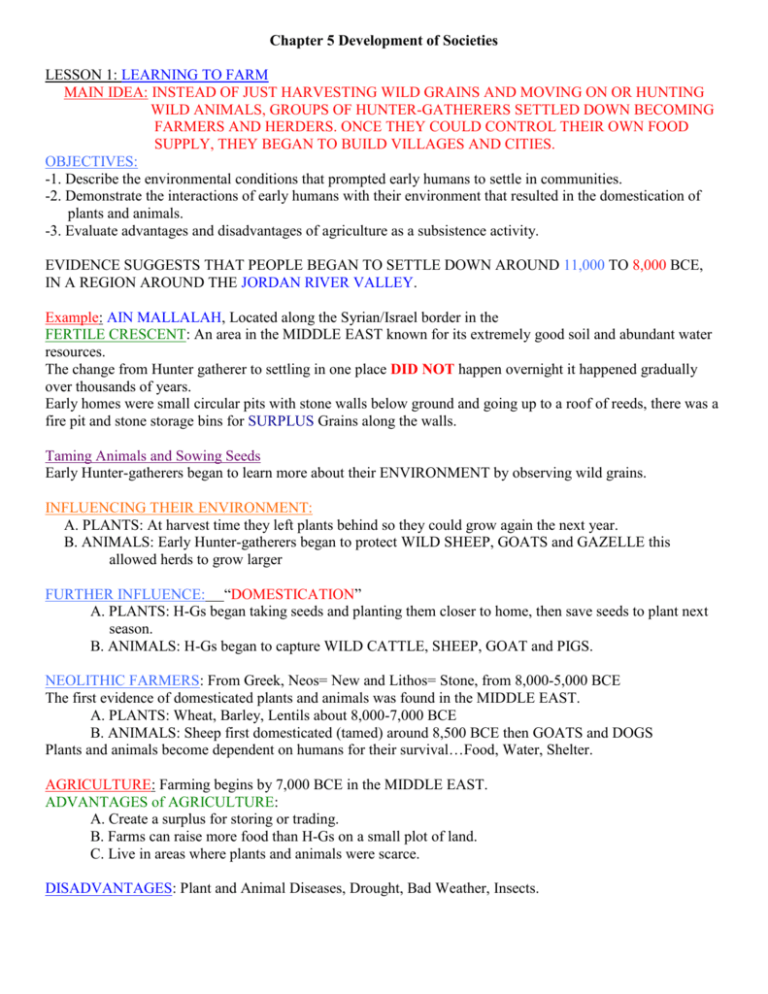
Chapter 5 Development of Societies LESSON 1: LEARNING TO FARM MAIN IDEA: INSTEAD OF JUST HARVESTING WILD GRAINS AND MOVING ON OR HUNTING WILD ANIMALS, GROUPS OF HUNTER-GATHERERS SETTLED DOWN BECOMING FARMERS AND HERDERS. ONCE THEY COULD CONTROL THEIR OWN FOOD SUPPLY, THEY BEGAN TO BUILD VILLAGES AND CITIES. OBJECTIVES: -1. Describe the environmental conditions that prompted early humans to settle in communities. -2. Demonstrate the interactions of early humans with their environment that resulted in the domestication of plants and animals. -3. Evaluate advantages and disadvantages of agriculture as a subsistence activity. EVIDENCE SUGGESTS THAT PEOPLE BEGAN TO SETTLE DOWN AROUND 11,000 TO 8,000 BCE, IN A REGION AROUND THE JORDAN RIVER VALLEY. Example: AIN MALLALAH, Located along the Syrian/Israel border in the FERTILE CRESCENT: An area in the MIDDLE EAST known for its extremely good soil and abundant water resources. The change from Hunter gatherer to settling in one place DID NOT happen overnight it happened gradually over thousands of years. Early homes were small circular pits with stone walls below ground and going up to a roof of reeds, there was a fire pit and stone storage bins for SURPLUS Grains along the walls. Taming Animals and Sowing Seeds Early Hunter-gatherers began to learn more about their ENVIRONMENT by observing wild grains. INFLUENCING THEIR ENVIRONMENT: A. PLANTS: At harvest time they left plants behind so they could grow again the next year. B. ANIMALS: Early Hunter-gatherers began to protect WILD SHEEP, GOATS and GAZELLE this allowed herds to grow larger FURTHER INFLUENCE: “DOMESTICATION” A. PLANTS: H-Gs began taking seeds and planting them closer to home, then save seeds to plant next season. B. ANIMALS: H-Gs began to capture WILD CATTLE, SHEEP, GOAT and PIGS. NEOLITHIC FARMERS: From Greek, Neos= New and Lithos= Stone, from 8,000-5,000 BCE The first evidence of domesticated plants and animals was found in the MIDDLE EAST. A. PLANTS: Wheat, Barley, Lentils about 8,000-7,000 BCE B. ANIMALS: Sheep first domesticated (tamed) around 8,500 BCE then GOATS and DOGS Plants and animals become dependent on humans for their survival…Food, Water, Shelter. AGRICULTURE: Farming begins by 7,000 BCE in the MIDDLE EAST. ADVANTAGES of AGRICULTURE: A. Create a surplus for storing or trading. B. Farms can raise more food than H-Gs on a small plot of land. C. Live in areas where plants and animals were scarce. DISADVANTAGES: Plant and Animal Diseases, Drought, Bad Weather, Insects. CAUSE and EFFECT of AGRICULTURE Because of Agriculture people: DIVISION of LABOR A. Could do other jobs, tool maker, builders, fishers, craftspeople, priests B. People began to change their environments and lifestyles forever. C. People began to settle in villages, make pottery, weave cloth and baskets D. Near the end of the Neolithic period they began using copper, then bronze. LESSON 2: LIVING IN AN EARL FARMING TOWN: Çatal Hüyük (chah TUHL hoo YUHK) MAIN IDEA: AS EARLY HUMANS BEGAN TO SETTLE DOWN THEY DEVELOPED DIFFERENT CULTURES AND WAYS OF LIFE. THE DIFFERENT VILLAGES NEEDED TO TRADE WITH EACH OTHER FOR THE THINGS THEY NEEDED TO SURVIVE. OBJECTIVES: -1. Describe the elements of Neolithic culture. -2. Identify some examples of ancient trade networks A. Located in modern day Turkey. B. 6,000 BCE about 32 acres with about 1,000 houses with 5,000-6,000 people. C. No streets, houses connected, people crossed multi-level roofs to get around and into houses. DWELLINGS: A. Most houses had 2 rooms, small for storage, large for living and kitchen area with hearth and clay oven. B. Furniture was built in platforms connected to the wall used for tables, benches and beds. FARMING AND HUNTING: A. They grew wheat and hunted bear, deer, wolves and gathered Crab apples, berries, nuts. BURIAL PRACTICES: A. Relatives were buried under platforms in houses. B. Some buildings were shrines that could be used for different purposes. C. Shrines were decorated with sculptures of Bulls, Leopards, Rams; colorful paintings covered the walls with animals and village scenes. D. Çatal Hüyük probably became a religious center. FARMING ECONOMY: A. FERTILE SOIL and a RIVER helped the town grow. B. People began to move away and start new communities in the area. C. People planted seeds in the moist soil after the river flooded. D. They produced ample amounts of grain and raised cattle and had salt, reeds, wood and mud bricks which allowed them to easily survive. E. All These things made Çatal Hüyük SELF-SUFFICIENT. ÇATAL HÜYÜK CRAFTS: SMALL INDUSTRIES BEGIN A. People made tools by grinding and chipping stones. B. From Bone; needles, beads, hairpins, fish hooks. C. They wove woolen cloth and blankets. D. From Leather: pouches. E. From Wood: bowls and bowls with lids for storage. TRADE in the NEOLITHIC WORLD: Surplus; more than is needed. Scarcity; a lack of something. A. ÇATAL HÜYÜK: Was a trading hub with OBSIDIAN a black volcanic glass, very sharp. B. They trade raw obsidian and arrowheads, tools, mirrors of obsidian. C. They traded with UMM DABAGHIYAH (OOM dah bah GEE ah) between Tigris/Euphrates rivers. UMM DABAGHIYAH: (OOM dah bah GEE ah) A. Small town under 10 houses, but had long narrow buildings with “cells” for storage. B. They hunted ONAGER (AHN uh juhr) for its skin to Trade. C. They did not farm and were not self-sufficient but had to trade for their necessities and luxuries. D. They focused on trade and pioneered a new lifestyle. LESSON 3: STARTING CITIES: MAIN IDEA: AS POPULATIONS GREW LARGE CITIES DEVELOPED AND THIS LED TO THE NEED FOR PLANNING AND LEADERSHIP. THIS THEN ALLOWED CIVILIZATIONS TO DEVELOP WITH SPECIFIC CHARACTERISTICS AND FEATURES. OBJECTIVES: -1. Explain some of the factors that led to the development of cities and civilization. -2. Explain why this development took place if MESOPOTAMIA first. -3. Show that the development of cities and civilization in MESOPOTAMIA gave rise to the institutions that govern modern society. UR: City on the dry plains of the Tigris and Euphrates rivers, now Iraq. A. Survived by using IRRIGATION; they dug canals from the river to their crops. B. This allowed them to create a SURPLUS of food and avoid a FAMINE. 4. MAIN FEATURES OF A CITY: 1. PLANNING AND LEADERSHIP A. People work together and are organized by STRONG LEADERSHIP. EXAMPLE: UR’s irrigation system, Large Public Buildings like ZIGGURATS or Temples. 2. SPECIALIZED WORKERS…SPECIALIZATION OF LABOR EXAMPLE: UR’s chisel workers, gem cutters, fullers, metal workers, carpenters, leather workers, judges, doctors, musicians. 3. SOCIAL GROUPS: RICH and POOR EXAMPLE: UR had 3 levels of society 1. The top was the powerful Government Officials, Priests, and Soldiers. 2. Second were the Merchants, Teachers, Laborers, Farmers, and Craftspeople. 3. The bottom were slaves captured in battle. 4. TRADE: NEAR AND FAR: EXAMPLE: UR ; Traded Grain and Cloth for items they needed to survive like; Wood, Stone, Gems, Gold, Silver, Tin, Lead, Copper and Bronze. A. Priests kept records of goods that flowed in and out of the city showing UR was a key trading center. EARLY CIVILIZATION: A COMPLEX SOCIETY WITH 5 MAIN CHARACTERISTICS: 1. STABLE FOOD SUPPLY. 2. SPECIALIZATION OF LABOR 3. A SYSTEM OG GOVERNMENT 4. SOCIAL LEVELS 5. A HIGHLY DEVELOPED CULTURE: Art, Architecture, Religion, Music, Law, Writing.
